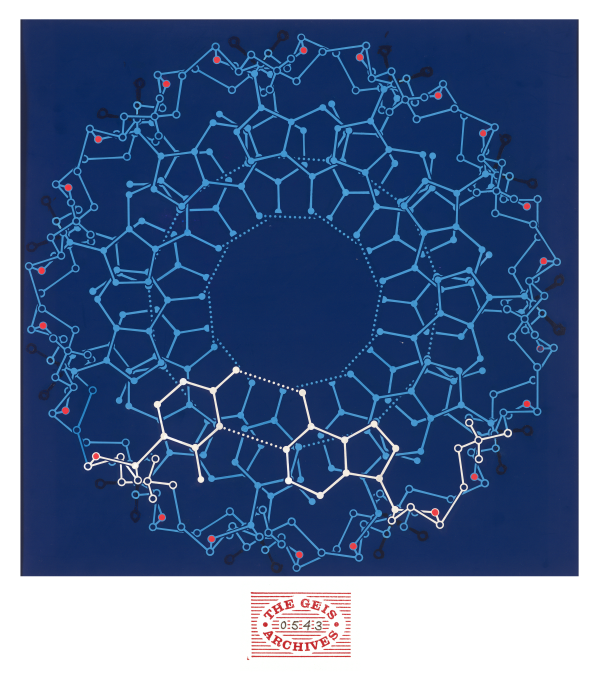A-DNA
Unknown Year, Unknown Dimensions

Geis uses a thin ball and stick representation of a section of A-DNA, the more compact conformation of DNA less often seen in biological systems. He draws it from a perspective looking down into the double helix, showing the increase in diameter of the middle of the helix from the B form DNA.
Used with permission from the Howard Hughes Medical Institute (www.hhmi.org). All rights reserved.

Related PDB Entry: 142D
Experimental Structure Citation
Mujeeb A1, Kerwin SM, Kenyon GL, James TL. (1993). Solution structure of a conserved DNA sequence from the HIV-1 genome: restrained molecular dynamics simulation with distance and torsion angle restraints derived from two-dimensional NMR spectra. Biochemistry. 32(49):13419-31.
About A-DNA
Deoxyribonucleic acid (DNA) is responsible for storing genetic information and contains all of the information that an organism needs to develop, grow, and survive. The DNA of an offspring contains information from the parent generation. The DNA A-helix exists under dehydrated conditions (Goodsell, 2001). It is right-handed and consists of 11 base pairs per turn ("B-Form, A-Form, Z-Form of DNA" website). In comparison to the B-helix (most common form of DNA), it has tipped bases and a deep major groove (Goodsell, 2001).
DNA is a chain of nucleotides, which are each composed of a deoxyribose, a phosphate group, and a base (adenine, thymine, guanine, or cytosine). The structure of DNA is a double-helix and base-pairing occurs between adenine and thymine and between guanine and cytosine (according to Chargaff’s rules). Adenine/thymine base-pairing consists of two hydrogen bonds and guanine/cytosine base-pairing consists of three hydrogen bonds. The sugar-phosphate backbone is closer in some portions of DNA.
Text References
Major and minor grooves. Boston University. URL: https://tandem.bu.edu/knex/grooves.knex.html
B-Form, A-Form, Z-Form of DNA. University of California, Davis. URL: http://biowiki.ucdavis.edu/Core/Genetics/Unit_I%3A_Genes%2C_Nucleic_Acids%2C_Genomes_and_Chromosomes/2%3A_Structures_of_nucleic_acids/B-Form%2C_A-Form%2C_Z-Form_of_DNA
Zheng G., Lu X. J., & Olson W. K. (2009). Web 3DNA—a web server for the analysis, reconstruction, and visualization of three-dimensional nucleic-acid structures. Nuc. Acids Res. 37 (Web Server Issue), W240-W246




